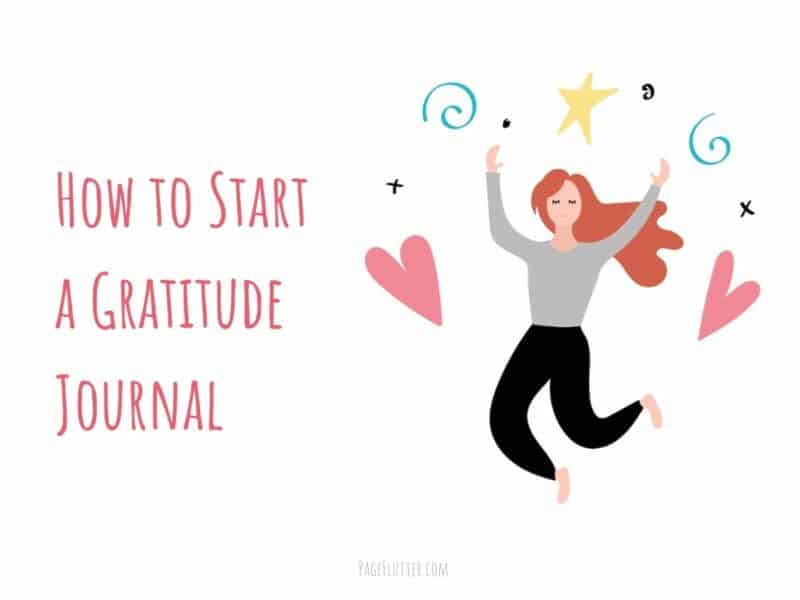If you’re looking for a way to jumpstart your day or just want to start finding more things to be grateful for, consider starting a gratitude journal.
It’s easy to get started, and can have a big impact on your life.
Just think – in as little as five minutes per day, you could see an increase in happiness, better sleep, and even improved physical health!
What are you waiting for?
If you want to get started with your gratitude journal today, we’ve got everything you need to know below!

What is a Gratitude Journal?
A gratitude journal is a notebook used to record moments or events for which one is thankful.
Writing in a gratitude journal has been shown to have psychological and physical benefits, including reducing stress, improving mood and mental well-being, and boosting immune function.
There are many different ways to keep a gratitude journal.
Some people prefer to write in it every day, while others only write when they feel they have something specific to be thankful for.
You can write down a list of things you’re grateful for, or write about a particular moment or event that made you feel thankful.
If you’re feeling stuck, drawing from a list of gratitude journaling questions and prompts can get you started.
There is no right or wrong way to keep a gratitude journal – the important thing is that it works for you, and it works best if you make it a habit.
Gratitude Journal Ideas to Get you Started
Things that happened during the day that made you feel happy or grateful
This includes big things (like a promotion at work) and small things (like a stranger holding the door open for you). It can also include events that are external or internal, like a particular feeling of positivity that washed over you at some point during the day.

People in your life who have made a positive impact
This could be friends, family, colleagues, or even someone you don’t know well who brightened your day.
Things you are looking forward to:
This could be an upcoming event, a vacation you’re planning, a book on your TBR list, or simply something you’re looking forward to doing in the near future.

Things you are grateful for in your life:
These could be material possessions, like a new letter writing kit or gorgeous new pens, experiences, or anything else that brings you happiness, like a freshly cleaned house in the spring!
Positive things that have happened to you:
This could be something that happened in the past or something happening right now.
It could also be positive things directly connected to aspects of your journaling practice, such as writing morning pages, completing the Empowered Journaling Challenge, Self-Discovery Journaling, or the Monthly Memoir Challenge.
Things you are proud of:
This could be accomplishments at work, making time for self-care, something notable in your personal life or family life, or anything else you feel good about.

They can be small things – like pulling off a stress-free Thanksgiving, or bigger things, like introducing your kids to a journaling practice.
Whatever you choose to include in your gratitude journal, the important thing is to take the time to reflect on the things you are grateful for and to express your gratitude regularly. Making your gratitude practice a keystone habit will help you cultivate a more positive outlook on life and appreciate the good moments, even when times are tough.
Benefits of Gratitude Journal:
Keeping your own gratitude journal is a simple but powerful tool that can help you cultivate a more positive outlook on life.
A gratitude journal helps you to take stock of all the blessings in your life, both big and small, and reflect on why you are grateful.
Daily gratitude practice can have many benefits for your mental and emotional well-being.
Here are eight reasons why you should consider starting a gratitude journal today.
1. Gratitude journaling can help you focus on the positive.
It’s easy to get caught up in the negative aspects of our lives and forget about all the good things we have going for us. Gratitude journaling forces you to take a step back and reflect on the things you are grateful for, which can help shift your focus from the negative to the positive.
2. It can improve your mental health.
Studies have shown that gratitude journaling can lead to improvements in mental health, including reductions in anxiety and depression. Additionally, gratitude practice has been linked with increased self-esteem and overall life satisfaction. If you’re struggling with mental health issues, focusing on small habit changes and adding gratitude journaling may be helpful tools to consider.
3. Gratitude journaling can boost your immune system.
In one study, participants who wrote about things they were grateful for experienced increased level of antibodies compared to those who didn’t journal about gratitude. This suggests that gratitude journaling may help boost your immune system and protect you from getting sick.

4. Regular gratitude journaling can improve your sleep quality.
If you’re having trouble sleeping, gratitude journaling may help. One study found that participants who wrote about things they were grateful for before bed experienced improved sleep quality compared to those who didn’t journal about gratitude. So if you’re struggling to get a good night’s sleep, give gratitude journaling a try.
5. Gratitude journaling can increase your resilience in the face of stress.
Studies have shown that gratitude can increase our resilience in the face of stress and adversity. If you’re going through a tough time, gratitude journaling may help you cope with the stress and come out stronger on the other side.
6. Practicing gratitude through your journal can lower your blood pressure.
In one study, participants who wrote about things they were grateful for experienced lower blood pressure than those who didn’t journal about gratitude. This suggests that gratitude journaling may be beneficial for those at risk for hypertension or other cardiovascular problems
7. Gratitude journaling can improve your relationships.
Gratitude has been linked with increased relationship satisfaction and closeness. If you’re looking to improve your relationships, gratitude journaling may be a helpful tool.

8. A gratitude journal can make you happier.
Overall, gratitude has been linked with increased happiness and more positive emotions and life satisfaction. If you’re looking for a simple way to boost your mood, gratitude journaling may be the answer.
If you’re interested in starting a gratitude journal, there are a few things to keep in mind.
First, be sure to set aside some time each day or week to write in your journal. Second, make an effort to focus on specific things that you are grateful for rather than general thoughts of gratitude.

And finally, don’t forget to be patient – it may take some time to see the benefits of gratitude journaling. But if you stick with it, you’re likely to see positive changes in your mental and emotional well-being.
Why is a Regular Gratitude Practice Important?
Why is Gratitude Important?
Well, first of all, gratitude is important because it is an affirmation of goodness. In the face of difficulties and setbacks, gratitude practice allows us to maintain a positive attitude and outlook. Additionally, gratitude has been linked with greater happiness, better health, stronger relationships, and increased productivity. Finally, gratitude simply feels good! When we take the time to express our thanks for the good in our lives, we open ourselves up to even more blessings.
So why not make a commitment to your gratitude journey each day?
You can start by keeping a gratitude journal or sharing your gratefulness with others. As you focus on the positive, you’ll find that your life becomes richer and fuller. Gratitude truly is one of the most important keys to happiness and success!
How to Start a Gratitude Journal
The benefits of gratitude journaling are well-documented. Not only can it improve your mood and outlook on life, but it can also boost your immune system, increase resilience in the face of stress, and promote overall physical and mental well-being.
Starting a gratitude journal is easy – all you need is a notebook and a pen! Here are some tips to get you started with a new gratitude journal:
1. Set aside time each day to write in your journal.
Whether it’s first thing in the morning or right before bed, find a time that works for you and stick to it.
2. Make sure to date each entry
This will help you keep track of your progress over time.
3. Write down at least three things you’re grateful for each day.
They can be big or small, but the important thing is to be specific. For example, instead of simply writing “I’m grateful for my family,” try something like “I’m grateful for my mom always being there for me” or “I’m grateful for being able to spend time with my cousins this weekend.” Noting down positive emotion and what brought it on is also a good idea.
4. Be creative!
You can use your own journal to express yourself in any way you choose. Some people like to include drawings or quotes along with their entries. Others prefer to keep it simple with just a few words.
If great pens and lovely notebooks will make you more likely to stick with it, by all means load up on supplies!

5. Keep your journal somewhere safe and accessible so you can refer back to it whenever you need a pick-me-up
When negative events throw you for a loop, or you simply can’t get a positive attitude happening for the day, looking back through your gratitude journal can make all the difference in reminding you to feel grateful.
How to Gratitude Journal
Knowing how to come up with a gratitude journal is one thing, but getting started is another.
If you’re not sure how to get started with your gratitude journal, here are some tips on how to practice gratitude with your journal.
1) Figure out what format works best for you.
Some people prefer to write in a traditional journal, while others prefer to use a gratitude app or even just a piece of paper. Even though this website is all about paper journaling, there’s really no wrong answer here. Go with whatever feels most comfortable for you.
2) Make it a daily habit.
The key to making a gratitude journaling practice effective is to do it regularly and make it part of your daily life.
As your gratitude practice should be a daily thing, aim to write in your journal every day, even if it’s just for a few minutes. Making it part of your morning routine or evening routine is a good bet when you’re starting the new habit.
3) Be specific.
When you’re brainstorming things to be grateful for, try to get as specific as possible. For example, rather than simply listing “my family,” try to brainstorm specific things you’re grateful for about your loved ones.
4) Write down the positive things that happen to you.
In addition to brainstorming things you’re grateful for, make sure to also jot down any positive experiences or accomplishments throughout your day.
5) Don’t be afraid to get creative.
Some people prefer to stick to traditional journaling, while others like to get creative with their entries. If you’re feeling stuck, try writing a gratitude poem or even drawing a picture of something you’re thankful for.
By following these tips, you can set yourself up for success with your gratitude journaling practice. Remember, the key is to be consistent and specific with your entries. Make it a habit that you stick with over time. With a little bit of effort, you’ll be well on your way to reaping the benefits of a gratitude journal!
Do gratitude journals really work?
There’s no shortage of self-help advice out there telling us that we should keep a gratitude journal. The idea is simple: every day, you write down a few things that you’re grateful for. Over time, the thinking goes, this practice will help to shift your focus from negative to positive experiences and make you feel happier overall.
But does it really work?
The answer appears to be yes – but with some important caveats.
For starters, gratitude journals need to be used consistently in order to be effective. You can’t just do it once in a while and expect results; it needs to become a regular habit.
Second, the benefits of writing a gratitude journal are most likely to accrue over the long term. In other words, don’t expect to feel an immediate difference after a few days or even weeks of writing. It may take months or even years of consistent journaling before you start to see real benefits. Some people like to combine gratitude journaling with mood tracking, using a journal habit tracker, to track changes in their outlook.
Third, it’s important to be specific when you’re writing in your gratitude journal. Generic statements like “I’m grateful for my family” are fine. But they’re not as effective as more specific entries like “I’m grateful for my husband’s sense of humor,” “I’m grateful for my daughter’s smile,” or “I’m grateful for the cozy weekend evening I spent with my husband and kids on Saturday.”
Finally, gratitude journals work best when they’re used in conjunction with other positive psychology interventions like meditation and mindfulness. If you’re looking to boost the effectiveness of your journaling, be sure to also incorporate some other proven techniques into your self-care routine.
Overall, then, gratitude journaling is a valuable tool – but it’s not a magic bullet. Used consistently and in combination with other positive practices, it can help you to shift your focus from negative to positive experiences. Through this, it can make you feel happier overall.
Summary
It’s easy to start a gratitude journal.
Just pick up a notebook or use the notes app on your phone. Start by writing down five things you are grateful for each day.
You can be as specific or general as you like to get started. The most important thing is to make it a habit, so try to do it every day.
What are you waiting for?
Start your gratitude journal today!



